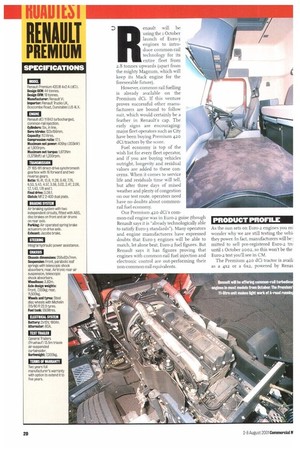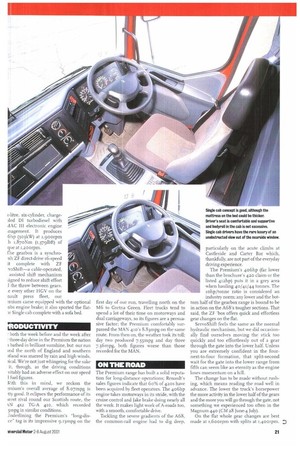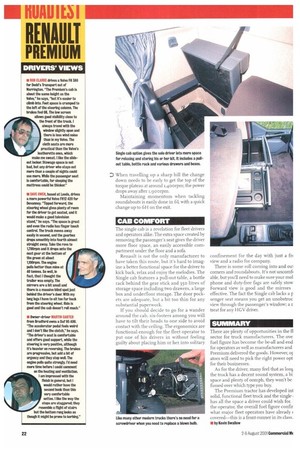enault will be using the i October launch of Euro-3
Page 20

Page 21

Page 22

If you've noticed an error in this article please click here to report it so we can fix it.
engines to introduce common-rail technology for its entire fleet from 2,8 tonnes upwards (apart from the mighty Magnum, which will keep its Mack engine for the foreseeable future).
However, common rail fuelling is already available on the Premium dCi. If this venture proves successful other manufacturers are bound to follow suit, which would certainly be a feather in Renault's cap. The early signs are encouraging: major fleet operators such as City have been buying Premium 420 dCi tractors by the score.
Fuel economy is top of the wish list for every fleet operator, and if you are buying vehicles outright, longevity and residual values are added to these con. cerns. When it comes to service life and residuals time will tell, but after three days of mixed weather and plenty of congestion on our test route. operators need have no doubts about commonrail fuel economy
Our Premium 420 dCi's common-rail engine was in Euro-a guise (though Renault says it is "already technologically able to satisfy Euro-3 standards"). Many operators and engine manufacturers have expressed doubts that Euro-3 engines will be able to match, let alone beat, Euro-2 fuel figures. But Renault says it has figures proving that engines with common-rail fuel injection and electronic control are out-performing their non-common-rail equivalents.
PRODUCT PROFILE
As the sun sets on Euro-2 engines you rn] wonder why we are still testing the vehi, they power. In fact, manufacturers will be mitted to sell pre-registered Euro-a tee until i October 2002, so this won't be the Euro-a test you'll see in CM.
The Premium 420 dCi tractor is avail; as a 4x2 or a 6x2, powered by Renal [-litre, six-cylinder, charge)led DI turbodiesel with vIAC III electronic engine inagement. It produces 6hp (303kW) at 1,900rpm Ii 1,87oNm (1,3791bft) of que at 1,2oorpm.
['he gearbox is a synchro,sh ZF direct-drive 16-speed it complete with ZF -vo Shift—a cable-operated, assisted shift mechanism ;igned to reduce shift effort the throw between gears. .e every other HGV on the nault press fleet, our imium came equipped with the optional obs engine brake; it also sported the flat)r Single cab complete with a sofa bed.
ODUCTIVITY
: both the week before and the week after : three-day drive in the Premium the nation s bathed in brilliant sunshine, but our run ind the north of England and southern gland was marred by rain and high winds. We're not just whingeing for the sake it, though, as the driving conditions vitably had an adverse effect on our speed fuel figures.
With this in mind, we reckon the inium's overall average of 8.07mpg is ity good. It eclipses the performance of its irest rival round our Scottish route, the tN 4x2 TG-A 410, which recorded 5mpg in similar conditions.
Inderlining the Premium's "long-discc" tag is its impressive 9.13mpg on the first day of our run, travelling north on the M6 to Gretna Green. Fleet trucks tend to spend a lot of their time on motorways and dual carriageways, so its figures are a persuasive factor; the Premium comfortably surpassed the MAN 410's 8.83mpg on the same route. From then on, the weather took its toll; day two produced 7.55mpg and day three 7.36mpg, both figures worse than those recorded for the MAN.
ON THE ROAD
The Premium range has built a solid reputation for long-distance operations; Renault's sales figures indicate that 6o% of 420s have been acquired by fleet operators. The 4o6hp engine takes motorways in its stride, with the cruise control and Jake brake doing nearly all the work. It makes light work of A-roads too, with a smooth, comfortable drive.
Tackling the severe gradients of the A68, the common-rail engine had to dig deep, particularly on the acute climbs at Castleside and Carter Bar which, thankfully, are not part of the everyday driving experience.
The Premium's 4o 6hp (far lower than the brochure's 420 claim or the listed 41211p) puts it in a grey area when hauling 4o/41/44 tonnes. The iohp/tonne ratio is considered an industry norm; any lower and the bottom half of the gearbox range is bound to be in action on the A68's tougher sections, That said, the ZF 'box offers quick and effortless gear changes on the flat.
ServoShift feels the same as the normal hydraulic mechanism, but we did occasionally find ourselves moving the stick too quickly and too effortlessly out of a gear through the gate into the lower half. Unless you are extremely confident in the fournext-to-four formation, that split-second wait for the gate into the lower range from fifth can seem like an eternity as the engine loses momentum on a hill.
The change has to be made without rushing, which means reading the road well in advance. The lower the truck's horsepower the more activity in the lower half of the gears and the more you will go through the gate, not something we experienced too often in the Magnum 440 (CM 28 June-4 luly).
On the flat whole gear changes are best made at I,Goorprn with splits at t,400rpm. When travelling up a sharp hill the change down needs to be early to get the top of the torque plateau at around 1,400rpm; the power drops away after 1,900rpm.
Maintaining momentum when tackling roundabouts is easily done in 6L with a quick change up to 6H on the exit.
CAB COMFORT
The single cab is a revelation for fleet drivers and operators alike. The extra space created by removing the passenger's seat gives the driver more floor space, an easily accessible compartment under the floor and a sofa.
Renault is not the only manufacturer to have taken this route, but it's hard to imagine a better functional space for the driver to kick back, relax and enjoy the melodies. The Single cab features a pull-out table, a bottle rack behind the gear stick and 35o litres of storage space including two drawers, a large box and underfloor storage. The door pockets are adequate, but a bit too thin for any substantial paperwork.
If you should decide to go for a wander around the cab, six-footers among you will have to tilt their heads to one side to avoid contact with the ceiling. The ergonomics are functional enough for the fleet operator to put one of his drivers in without feeling guilty about placing him or her into solitary confinement for the day with just a fn view and a radio for company.
There is some roll coming into and oul corners and roundabouts. It's not uncomfi able, but you'll need to make sure your mol phone and duty-free fags are safely stow Forward view is good and the mirrors effective. The fact the Single cab lacks a p senger seat means you get an unobstruc view through the passenger's window; a r treat for any HGV driver.
SUMMARY
There are plenty of opportunities in the fl sector for truck manufacturers. The ove fuel figure has become the be-all and end for operators as well as manufacturers and Premium delivered the goods. However, of ators will need to pick the right power opt for their businesses.
As for the driver, many feel that as lorq the truck has a decent sound system, a hi space and plenty of oomph, they won't be fussed over which type you buy.
The Premium tractor has developed int solid, functional fleet truck and the single has all the space a driver could wish for. the operator, the overall fuel figure confir what major fleet operators have already < covered—this is a front-runner in its class.
• by Kevin Swallow




















































































































